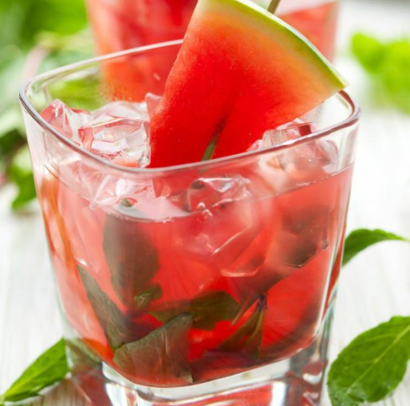

Find DJ SpecDrum at your favorite
social media outlet by clicking the images above.
This is as you probably know by now is a very funky song about watermelon. My family and I love watermelon. That being said, enjoying watermelon can be a very funky subject!
As Dave Chappele rightfully says, “There is something wrong with you if you don’t like chicken and watermelon, But why is there a stereotype to a piece of fruit? Here is some interesting information about Watermelon. Then maybe we can get to the bottom of this food conspiracy!”
Watermelon is thought to have originated in southern Africa, where it is found growing wild. It reaches maximum genetic diversity there, with sweet, bland and bitter forms. In the 19th century, Alphonse de Candolle[1] claimed the watermelon was indigenous to tropical Africa.[2] Though Citrullus colocynthis is often considered to be a wild ancestor of watermelon and is now found native in north and West Africa, it has been suggested on the basis of chloroplast DNA investigations that the cultivated and wild watermelon diverged independently from a common ancestor, possibly C. ecirrhosus from Namibia.[3]
Watermelon is also mentioned in the Bible as a food eaten by the ancient Israelites while they were in bondage in Egypt. (The more you read the dumber the stigma attached to Watermelon seems)
(This is where it gets interesting) Watermelons were grown by Native Americans in the 16th century. Early French explorers found the fruit being cultivated in the Mississippi Valley. Many sources list the watermelon as being introduced in Massachusetts as early as 1629. Southern food historian John Egerton has said he believes African slaves helped introduce the watermelon to the United States. Texas Agricultural Extension horticulturalist Jerry Parsons lists African slaves and European colonists as having distributed watermelons to many areas of the world. Parsons also mentions the crop being farmed by Native Americans in Florida (by 1664) and the Colorado River area (by 1799). Other early watermelon sightings include the Midwestern states (1673), Connecticut (1747) and the Illiana region.
So let get this right, The Native Americans were growing it BEFORE SLAVES were brought to this country and Europe Colonist also helped spread the crop around this country! Correct me if I’m wrong but I don’t think that there were not to many Black European Colonist?
Yes Black people love Watermelon and White people too and so do the Turks, Iranians. (Number 2 and 3 on the highest producers of Water Melon) So thank the Native Americans Maybe we can give them CREDIT FOR SOMETHING!! But to be honest with we are number 5 in the world for Water Melon producers. In case you were wondering China is number 1.
Here are some Cultural references:
I hope I have helped bring down some of the most ridicules prejudices out there. Be defined by who you are as a person not what you EAT!
I will leave you with this recipe, I the hopes it will bring you and the people you know closer together!

Mojito de Sandia
Recipe from "Fiesta at Rick's" cookbook
Makes 8 12-ounce drinks
8 large sprigs of fresh
mint
4 cups cubed seedless
watermelon—3/4-inch cubes are perfect here
1/2 cup Simple
Syrup
Ice cubes (you’ll need about 2
quarts)
2 cups white rum (I like D’Aristi
rum from Yucatan)
1/2 cup lime juice
Sparkling water or club
soda
Set out 8 tall 12-ounce glasses. Into each glass strip off the leaves from a single sprig of mint—you’ll need about 10 leaves for each drink—and top with 1/2 cup watermelon cubes. Divide the Simple Syrup among the glasses (1 tablespoon - 1/2 ounce per glass). Use a muddler (or the handle of a wooden spoon or a long-handle ice tea spoon—though neither is anywhere near as effective) to crush the mint and watermelon, releasing their flavor into the syrup—the more muddling, the fuller the flavors. Fill each glass with ice. Measure in the rum (1/4 cup - 2 ounces per glass) and the lime juice (1 tablespoon - 1/2 ounce per glass). Use a long-handle ice tea spoon to mix everything together. Top off each glass with a little sparkling water or soda and you’re ready to serve.
(Courtesy of Rick Bayless)